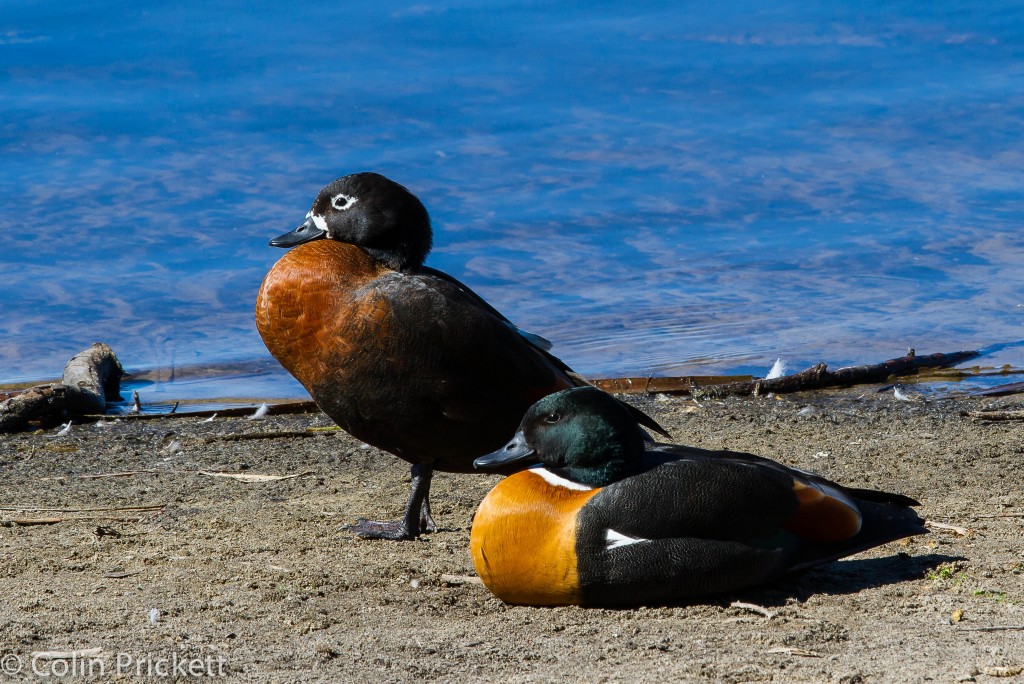
Twelve members attended our April field trip at Bibra Lake on a beautiful autumn morning. On first impressions there appeared to be plenty of water in the lake. But it soon became apparent that the water level was quite low. The giveaway was the presence of Black Winged Stilts out in the centre of the lake, a species normally found wading in the shallows. However, the shallow depth resulted in perfect conditions for the Yellow-billed Spoonbills and Australian Shovellers (right), both species being present in very large numbers, with approximately 90 of the Yellow-billed Spoonbills spread out over the lake. There must be lots of aquatic life for them to feed on.
Above the lake Welcome Swallows and Tree Martins were active, feeding on insects. A total of 33 bird species were recorded as shown in the list on Page 2. A special sighting was a solitary Glossy Ibis found close to a group of Australian White Ibis towards the northern end of the lake. Three species of raptor were spotted above the lake, a Little Eagle, a Square-tailed Kite and a Brown Goshawk, the appearance of each resulting in panic amongst the smaller water birds who took to the air to escape the threat.
While many of us were focused on the water birds Otto Mueller and Daniel Heald were finding many different species of invertebrates. Otto showed us tufts of spider web on the tips of Melaleuca saplings, which he said he has inspected under a microscope and found three tiny spiders. Spiders included various small orbweavers and long-jawed orbweavers, and Edible Golden Orbweaver (Nephila edulis, Family NEPHILIDAE); Long-jawed Orbweaver (Tetragnatha sp., Fam. TETRAGNATHIDAE) ; Rural Crab Spider (Tharpyna campestrata, Fam. THOMISIDAE). Long-jawed Orbweavers use their very large jaws to hold the female’s jaws apart during mating. Rural Crabs are found across Australia. Females and their eggs are usually hidden under bark, while the males are most often seen wandering. Otto also found mites and an undescribed beetle. A nice sighting was a Metallic Green Soldier Fly (Odontomyia sp. Fam. STRATIOMYIDAE).
Other flies included Australian Sheep Blowfly (Lucilia cuprina, Fam. CALLIPHORIDAE); Brown Blowfly (Calliphora sp. Fam. CALLIPHORIDAE); tiny hoverflies (Fam. SYRPHIDAE) – all three hovering around or pollinating a particular pungent shrub in bloom.

In the long incredibly sticky grass beside the lake Daniel found a late-instar Tropical Armyworm or Cluster Caterpillar (Spodoptera litura, Fam. NOCTUIDAE); a Budworm Moth (Helicoverpa sp. Fam. NOCTUIDAE) and Beet Webworm Moth (Spoladea recurvalis, Fam. CRAMBIDAE. All three are agricultural pests.
There were also true bugs – Lerps, scale insects, adult psyllids, Hymenoptera – feral honeybees; and leaf-mining sawflies, probably the Leaf-blister Sawfly (Phylacteophaga froggatti, Fam. PERGIDAE), an Eastern species that’s become rather invasive in Western Australia, but is being checked, somewhat, by our local parasitoids
Various ants, include tiny ones nesting inside paperbark, and Valentine or Acrobat Ants (Crematogaster sp., Fam. FORMICIDAE) on another tree. So-named from their heart-shaped gasters, and arboreal habits.
Various dragonfly and damselfly nymph exuviae, some a good distance from the water. A large day-flying moth was seen flying overhead but was not identified.
Fungi sightings included Woody Layered Bracket Fungus (Fomitiporia robusta, Fam. HYMENOCHATACEAE) and Shaggy Parasol (Chlorophyllum brunneum, Fam. AGARICACEAE).
A tube attached or protruding from the trunk of a tree was identified as a Tube Concealer Moth – Hemibela sp. Fam OECOPHORIDAE. They hollow out a small length of twig and stay protected inside, just poking out the head and thorax out to feed. They all feed on eucalypts, grow to a length of about 1 cm and pupate inside their tube, which they first secure to a flat surface.
A row of large brown insect eggs on a tree trunk were later identified as Emperor Gum Moth, Opodiphthera eucalypti, Fam. SATURNIIDAE.
One eucalypt near the footpath contained a bait/monitoring station for Queensland fruit fly.

While making our way to the picnic area near the car park we noticed that a group of around 50 Spoonbills had congregated across the lake, having eaten their fill for the time being. It was quite a sight to see so many together. All too soon it was time for a snack and cuppa, following which most left for home after a great and informative walk. Thanks to Otto for leading the walk and to Daniel for the invertebrate details.
Colin Prickett
See Page 2 for bird list

